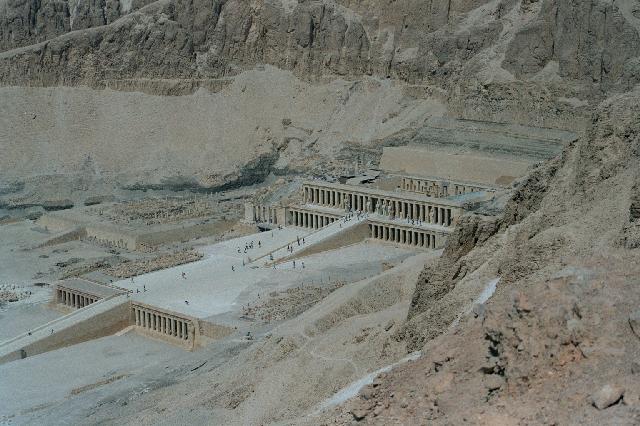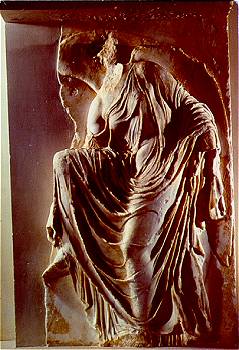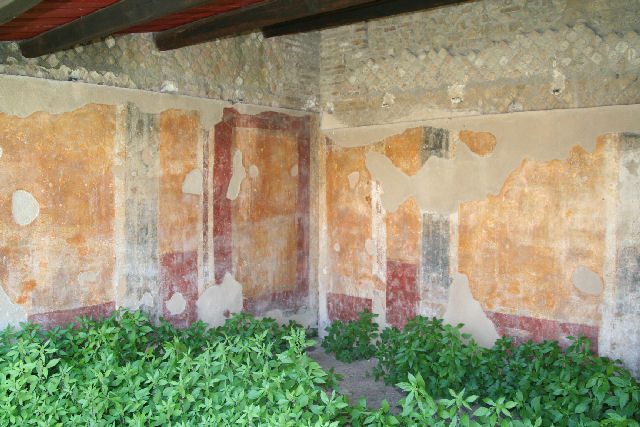
|
|
paleolithic
Lascaux Cave Painting Paleolithic 15,000 B.C. |

|
|
paleolithic
Altamira cave paintings Paleolithic 15,000 B.C.
wtfdoesitmean: Depicts a wounded bison in a fetal position. Very sensitively created with natural pigments. Some pigments are sprayed on. The world's first "airbrush" painting. |

|
|
paleolithic Venus of Willendorf Paleolithic 28,000 B.C. Willendorf, Austria
Fettish sized. Sculpted from stone with stone tools yet she is amazingly sensitive and fleshy. Fertility aspects are accentuated and the face, feet, and hands are minimalized, hence the name, "Venus". She and several similar Paleolithic "Venuses" give evidence of the belief in a great goddess and perhaps the existence of matriarchal beliefs in prehistoric culture. |

|
|
Stonehenge Neolithic 2000 B.C.
-Megalithic stone post and lintel construction |

|
|
Jericho- Great Stone Tower neolithic 8,000-7,000 B.C. Jericho, Israel
Jerico may be man's oldest permanent city. It was amazingly sophisticated despite the fact that it was created with stone tools. It was quite self-contained with it's own well and grain silos. Mud brick houses built on oval stone foundations covered about ten acres. A rock-cut ditch and a 5 foot thick stone wall surrounded a population of about 2000 people. The wall was 13 feet high and encompassed a 28 foot stone tower. This tower was 33 feet wide at the base and contained a spiral staircase inside. Thus begins man's long history of monumental stone architecture. |

|
|
Schematic Plan of Catal Huyuk Neolithic 6,000-5,900 B.C. Catal Huyuk, Turkey
Catal Huyuk (pronounced Chatall Hooyook) is the second oldest civilized settlement to be excavated. The plan of this city is unusual because there are no streets. Inhabitants of this city walked across timber and rush roofs to get from one point to another. Openings in the roofs were fitted with ladders for access into each house perhaps to keep wild animals out. Ulike Jericho there were no walls or defense towers at Catal Huyuk. The houses were covered with white painted stucco. |
|
|
|
paleolithic
Waterworn pebble resembling a human face, from Makapansgat, South Africa, ca. 3,000,000 BCE. Reddish brown jasperite, approx. 2 3/8” wide.
|

|
|
paleolithic Aurochs, horses, and rhinoceroses, wall painting in Chauvet Cave, Vallon-Pont-d’Arc, Ardèche, France, ca. 30,000–28,000 or ca. 15,000–13,000 BCE. Approx. half life-size.
|

|
|
paleolithic Animal facing left, from the Apollo 11 Cave, Namibia, ca. 23,000 BCE. Charcoal on stone, approx. 5” X 4 1/4”.
|

|
|
neolithic Deer hunt, Catal Huyuk
PEOPLE!
stylized massively. rigid. movement. |

|
|
paleolithic
|

|
|
neolithic Human skull with restored features, Jericho |

|
|
paleolithic Reclining woman, rock-cut relief, La Magdelaine cave, Tarn, France, ca. 12,000 BCE. Approx. half life-size.
|

|
|
paleolithic Bison with turned head, fragmentary spearthrower, from La Madeleine, Dordogne, France, ca. 12,000 BCE. Reindeer horn, approx. 4” long.
|

|
|
Signs, consisting of checks, dots, squares, or other arrangements of lines often accompany the pictures of animals. Representations of human hands also are common.
Spotted horses and negative hand imprints, wall painting in the cave at Pech-Merle, Lot, France, ca. 22,000 BCE.
|
|
|
|
paleolithic Perhaps the most perplexing painting in all the Paleolithic caves shows a man, a rhinoceros, and a wounded bison. Researchers can be sure of nothing, but if the figures were placed beside each other to tell a story, then this is evidence for the creation of complex narrative compositions involving humans and animals at a much earlier date than previously imagined. 1-13: Rhinoceros, wounded man, and disemboweled bison, painting in the well, Lascaux, Dordogne, France, ca. 15,000–13,000 BCE. Bison approx. 3’ 8” long. |

|
|
neolithic
The inhabitants of Ain Ghazal built houses or irregularly shaped stones, but carefully plastered and then painted their floors and walls red. 1-15: Human figure, from Ain Ghazal, Jordan, ca. 6750-6250 BCE. Plaster, painted and inlaid with cowrie shell and bitumen, 3' 5 3/8 high. Louvre, Paris. |

|
|
neolithic
Warka vase, Uruk: 3000 BCE, Uruk in Southern Iraq (Photo from pg. 61 of M. Roaf's Cultural Atlans of Mesopotamia and the Ancient Near East). This vase is covered with scenes of offerings for the goddess Inanna. She and the King are shown in the top register. |
|
|
|
neolithic
Detail from "Great Lyre" from Ur: Ht 33 cm. 2550 - 2400 BCE, royal tomb at Ur (Photo from pg. 106 of J. Aruz and R. Wallenfels (eds.) 2003 Art of the First Cities). The front panel of the sound box from the so-called Great Lyre was recovered among grave goods in the royal tomb at Ur. The panel is made of shell and bitumen and is divided into four registers. The top panel is of a male embracing two human headed bulls, the three lower panels show scenes from a funerary banquet in which animals play the roles normally assumed by humans. |

|
|
neolithic
Votive statues from Tell Asmar: Ht (tallest figure) 72 cm. 2,700 BCE, Tell Asmar, Mesopotamia (Photo from pg. 61 of D. Collon's 1995 Ancient Near Eastern Art). In this collection, found in the Abu Temple, there are eight bearded standing male figures, one clean-shaven standing male, one kneeling male, and two standing females. All of the figures display large wide open eyes, many of which are inlaid. Additionally, some of the figure's eyebrows are also inlaid. Males wear fringed skirts and belts and females wear robes with a cloak draped over the left shoulder. All of the figures hold their hands before them, many are clasping a cup. The figures are thought to represent worshippers.
|

|
|
neolithic
Cylinder seal: Ht. 3.6 cm. 2,220 - 2,159 BCE, Mesopotamia (Photo from pg. 216 of J. Aruz and R. Wallenfels (eds.) 2003 Art of the First Cities). This Akkadian example of a seal impression shows a hero wrestling with a water buffalo (left) and a bull-man struggling with a lion (right). The figures are separated by a tree on a mountain. The hero faces the viewer and dominates the scene. Akkadian seals tend to be arranged into clusters of figures that display physical tension in scenes of active combat. |

|
|
neolithic
•Ziggurat (northeastern facade with restored stairs), Ur (modern Tell Muqayyar), Iraq, ca. 2100 BCE.
|

|
|
neolithic
•Head of an Akkadian ruler, from Nineveh (modern Kuyunjik), Iraq, ca. 2250–2200 BCE. Copper, 1’ 2 3/8” high. Iraq Museum, Baghdad.
|
|
|
|
paleolithic Human with feline head, from Hohlenstein-Stadel, Germany, ca. 30,000–28,000 BCE. Mammoth ivory, 11 5/8” high. Ulmer Museum, Ulm.
|
 |
|
paleolithic Spotted horses and negative hand imprints, wall painting in the cave at Pech-Merle, Lot, France, ca. 22,000 BCE. Approx. 11’ 2” long.
|
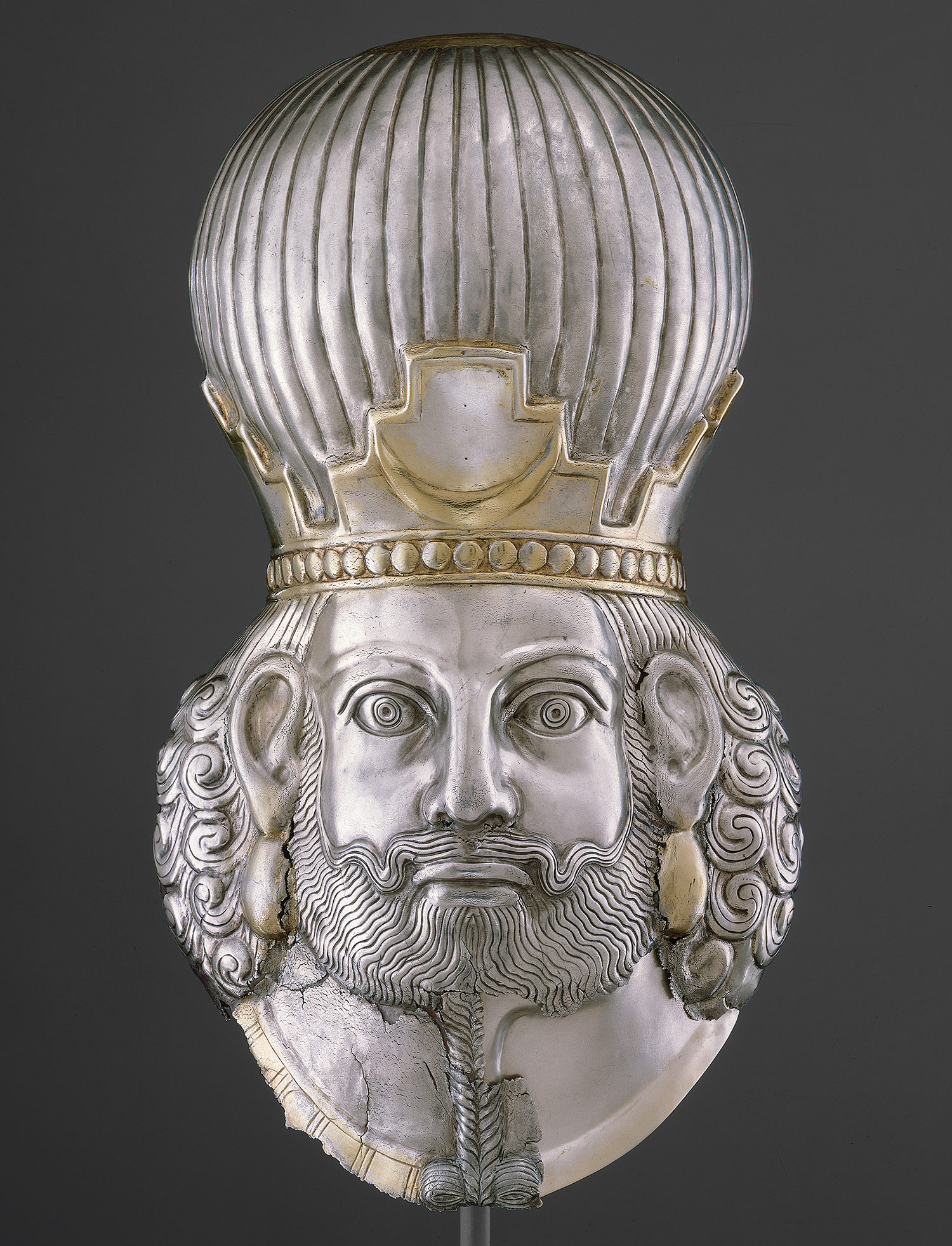
|
|
neolithic •Head of a Sasanian king (Shapur II?), ca. 350 CE. Silver with mercury gilding, 1’ 3 3/4” high. Metropolitan Museum of Art, New York.
|

|
|
neolithic •Statuettes of two worshipers, from the Square Temple at Eshnunna (modern Tell Asmar), Iraq, ca. 2700 BCE. Gypsum inlaid with shell and black limestone, tallest figure approx. 2’ 6” high. Iraq Museum, Baghdad.
|

|
|
•War side of the Standard of Ur, from Tomb 779, Royal Cemetery, Ur (modern Tell Muqayyar), Iraq, ca. 2600 BCE. Wood inlaid with shell, lapis lazuli, and red limestone, approx. 8” x 1’ 7”. British Museum, London.
|

|
|
neolithic •Ziggurat (northeastern facade with restored stairs), Ur (modern Tell Muqayyar), Iraq, ca. 2100 BCE.
|

|
|
neolithic •Banquet scene, cylinder seal (left) and its modern impression (right), from the tomb of Pu-abi (tomb 800), Royal Cemetery, Ur (modern Tell Muqayyar), Iraq, ca. 2600 BCE. Lapis lazuli, approx. 2” high. British Museum, London.
|

|
|
akkadian •Victory stele of Naram-Sin, from Susa, Iran, 2254–2218 BCE. Pink sandstone, approx. 6’ 7” high. Louvre, Paris.
|

|
|
•Stele with law code of Hammurabi, from Susa, Iran, ca. 1780 BCE. Basalt, approx. 7’ 4” high. Louvre, Paris.
|

|
|
assyrian •Lamassu (winged, human-headed bull), from the citadel of Sargon II, Dur Sharrukin (modern Khorsabad), Iraq, ca. 720–705 BCE. Limestone, approx. 13’ 10” high.
|

|
|
•Assyrian archers pursuing enemies, relief from the Northwest Palace of Ashurnasirpal II, Kalhu (modern Nimrud), Iraq, ca. 875–860 BCE. Gypsum, 2’ 10 5/8” high. British Museum, London.
|

|
|
•Ashurbanipal hunting lions, relief from the North Palace of Ashurbanipal, Nineveh (modern Kuyunjik), Iraq, ca. 645–640 BCE. Gypsum, 5’ 4” high. British Museum, London.
|

|
|
Sumerian •Fragment of the victory stele of Eannatum (Stele of the Vultures), from Girsu (modern Telloh), Syria, ca. 2600–2500 BCE. Limestone, full stele approx. 5’ 11” high. Louvre, Paris.
|
|
•Seated statuette of Urnanshe, from the Ishtar temple at Mari (modern Tell Hariri), Syria, ca. 2600–2500 BCE. Gypsum inlaid with shell and lapis lazuli, 10 1/4” high. National Museum, Damascus.
|

|
|
Sumerian •Bull-headed lyre (restored) from Tomb 789 (“King’s Grave”), Royal Cemetery, Ur (modern Tell Muqayyar), Iraq, ca. 2600 BCE. Gold leaf and lapis lazuli over a wooden core, approx. 5’ 5” high. University Museum, University of Pennsylvania, Philadelphia.
|

|
|
•Seated statue of Gudea holding temple plan, from Girsu (modern Telloh), Iraq, ca. 2100 BCE. Diorite, approx. 2’ 5” high. Louvre, Paris.
|

|
|
•Investiture of Zimri-Lim, mural painting from Court 106 of the palace at Mari (modern Tell Hariri), Syria, ca. 1775–1760 BCE. Louvre, Paris.
|

|
|
•Lion Gate, Boghazköy, Turkey, ca. 1400 BCE. Limestone, lions approx. 7’ high.
|

|
|
•Statue of Queen Napir-Asu, from Susa, Iran, ca. 1350–1300 BCE. Bronze and copper, 4’ 2 3/4” high. Louvre, Paris.
|
|
|
|
•Reconstruction drawing of the citadel of Sargon II, Dur Sharrukin (modern Khorsabad), Iraq, ca. 720–705 BCE (after Charles Altman).
|
|
|
|
•Ashurnasirpal II with attendants and soldier, from his palace at Kalhu, Iraq, ca. 875–860 BCE. Glazed brick, 11 3/4” high.
|

|
| Ishtar Gate (restored), Babylon, Iraq, ca. 575 BCE. Glazed brick. Staatliche Museen, Berlin. |

|
|
•Processional frieze (detail) on the terrace of the royal audience hall (apadana), Persepolis, Iran, ca. 521–465 BCE.
|
|
|
|
•Palace of Shapur I, Ctesiphon, Iraq, ca. 250 CE.
|

|
|
•Triumph of Shapur I over Valerian, rock-cut relief, Bishapur, Iran, ca. 260 CE.
|
|
|
|
•(d.272 AD) Triumphing Over the Emperors Philippus the Arab and Valerian
|
|
|
|
Palette of King Narmer (left, back; right, front), from Hierakonpolis, Egypt, Predynastic, ca. 3000–2920 BCE. Slate, approx. 2’ 1” high
|
|
|
|
Section (left), plan (center), and restored view (right) of typical Egyptian mastaba tombs.
|

|
|
IMHOTEP, Stepped Pyramid and mortuary precinct of Djoser, Saqqara, Egypt, Dynasty III, ca. 2630–2611 BCE.
|

|
|
Columnar entrance corridor to the mortuary precinct of Djoser, Saqqara, Egypt, Dynasty III, ca. 2630–2611 BCE.
|
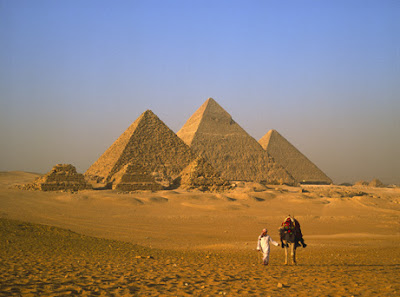
|
|
Great Pyramids, Gizeh, Egypt, Dynasty IV. From left: Pyramids of Menkaure, ca. 2490–2472 BCE; Khafre, ca. 2520–2494 BCE; and Khufu, ca. 2551–2528 BCE.
|
|
View from SSE, quasi-total with pyramid of Khufu (face in profile)
|

|
|
Menkaure and Khamerernebty (?), from Gizeh, Egypt, Dynasty IV, ca. 2490–2472 BCE. Graywacke, approx. 4’ 6 1/2” high. Museum of Fine Arts, Boston.
|

|
|
Seated Scribe (Kay?), from his mastaba at Saqqara
|

|
|
Ti watching a hippopotamus hunt, relief in the mastaba of Ti, Saqqara, Egypt, Dynasty V, ca. 2450–2350 BCE. Painted limestone, hunting scene approx. 4’ high.
|
|
|
|
Mortuary temple of Hatshepsut (with the Middle Kingdom mortuary temple of Mentuhotep II at left), Deir el-Bahri, Egypt, Dynasty XVIII, ca. 1473–1458 BCE.
|

|
|
Temple of Ramses II, Abu Simbel, Egypt, Dynasty XIX, ca. 1290–1224 BCE. Sandstone, colossi approx. 65’ high.
|

|
|
Fowling scene, from the tomb of Nebamun, Thebes, Egypt, Dynasty XVIII, ca. 1400–1350 BCE. Fresco on dry plaster, approx. 2’ 8” high.
|
 |
|
Musicians and dancers, detail of a fresco from the tomb of Nebamun, Thebes, Egypt, Dynasty XVIII, ca. 1400–1350 BCE. Fragment approx. 1’ x 2’ 3”. British Museum, London.
|

|
|
Tiye, from Gurob, Egypt, Dynasty XVIII, ca. 1353–1335 BCE. Wood, with gold, silver, alabaster, and lapis lazuli, approx.
|

|
|
Last judgment of Hu-Nefer, from his tomb at Thebes, Egypt, Dynasty XIX, ca. 1290–1280 BCE. Painted papyrus scroll, approx. 1’ 6” high.
|

|
|
People, boats, and animals, watercolor copy of a wall painting from tomb 100 at Hierakonpolis, Egypt, Predynastic, ca. 3500–3200 BCE. Paint on plaster, approx. 16’ 3” long.
|
|
Columnar Entrance Corridor, Mortuary Precinct of Zose
|
|
Facade of the North Palace of the mortuary precinct of Djoser, Saqqara, Egypt, Dynasty III, ca. 2630–2611 BCE.
|
|
Model of the pyramid complex, Gizeh, Egypt. Cambridge, Massachusetts, Harvard University Semitic Museum.
1. Pyramid of Menkaure, 2. Pyramid of Khafre, 3. Mortuary temple of Khafre, 4. Causeway, 5. Great Sphinx 6. Valley temple of Khafre, 7. Pyramid of Khufu, 8. Pyramids of the royal family and mastabas of nobles |
|
|
|
Great Sphinx (with Pyramid of Khafre in the background at left), Gizeh, Egypt, Dynasty IV, ca. 2520–2494 BCE. Sandstone, approx. 65’ high, 240’ long.
|

|
|
Khafre, from Gizeh, Egypt, Dynasty IV, ca. 2520–2494 BCE. Diorite, approx. 5’ 6” high. Egyptian Museum, Cairo.
|

|
|
Ka-Aper, from his mastaba at Saqqara, Egypt, Dynasty V, ca. 2450–2350 BCE. Wood, approx. 3’ 7” high. Egyptian Museum, Cairo.
|

|
|
Interior hall of the rock-cut tomb of Amenemhet (BH 2), Beni Hasan, Egypt, Dynasty XII, ca. 1950–1900 BCE.
|

|
|
Hatshepsut with offering jars, from the upper court of her mortuary temple, Deir el-Bahri, Egypt, ca. 1473–1458 BCE. Red granite, approx. 8’ 6” high. Metropolitan Museum of Art, New York.
|
|
|
|
Interior of the temple of Ramses II, Abu Simbel (now relocated), Egypt, Dynasty XIX, ca. 1290–1224 BCE. Sandstone, pillar statues approx. 32’ high.
|

|
|
Hypostyle hall, temple of Amen-Re, Karnak, Egypt, Dynasty XIX, ca. 1290–1224 BCE.
|
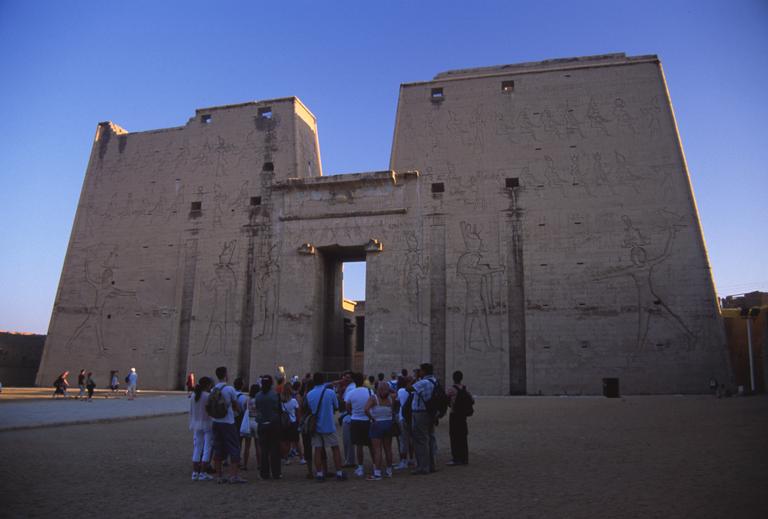
|
|
Temple of Horus, Edfu, Egypt, ca. 237–47 BCE.
|

|
|
Senmut with Princess Nefrua, from Thebes, Egypt, Dynasty XVIII, ca. 1470–1460 BCE. Granite, approx. 3’ 1/2” high. Ägyptisches Museum, Berlin.
|
|
|
|
Akhenaton, from the temple of Aton, Karnak, Egypt, Dynasty XVIII, ca. 1353–1335 BCE. Sandstone, approx. 13’ high
|
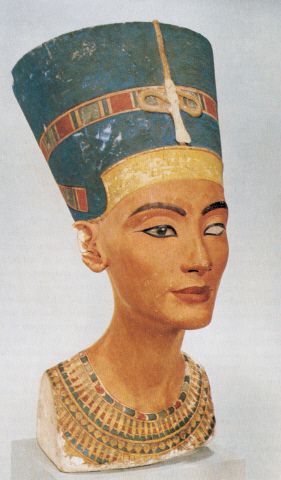
|
|
THUTMOSE, Nefertiti, from Tell el-Amarna, Egypt, Dynasty XVIII, ca. 1353–1335 BCE. Painted limestone, approx. 1’ 8” high. Ägyptisches Museum, Berlin.
|
|
|
|
Akhenaton, Nefertiti, and three daughters, from Tell el-Amarna, Egypt, Dynasty XVIII, ca. 1353–1335 BCE. Limestone, approx. 12 1/4” high. Ägyptisches Museum, Berlin.
|

|
|
Innermost coffin of Tutankhamen, from his tomb at Thebes, Egypt, Dynasty XVIII, ca. 1323 BCE. Gold with inlay of enamel and semiprecious stones, approx. 6’ 1” long.
|

|
|
Innermost coffin of Tutankhamen, from his tomb at Thebes, Egypt, Dynasty XVIII, ca. 1323 BCE. Gold with inlay of enamel and semiprecious stones, approx. 6’ 1” long.
|

|
|
Death mask of Tutankhamen, from the innermost coffin in his tomb at Thebes, Egypt, Dynasty XVIII, ca. 1323 BCE. Gold with inlay of semiprecious stones, 1’ 9 1/4” high.
|

|
|
Painted chest, from the Tomb of Tutankhamen, Thebes, Egypt, ca. 1333–1323 BCE. Wood, approx. 1’ 8” long.
|

|
|
Mentuemhet, from Karnak, Egypt, Dynasty XXVI, ca. 650 BCE. Granite, approx. 4’ 5” high. late
|

|
|
Figurine of a woman, from Syros (Cyclades), Greece, ca. 2500–2300 BCE. Marble, approx. 1’ 6” high.
|

|
|
Male lyre player, from Keros (Cyclades), Greece, ca. 2700–2500 BCE. Marble, approx. 9” high.
|

|
|
Aerial view (looking southwest) of the palace at Knossos (Crete), Greece, ca. 1700–1400 BCE.
|
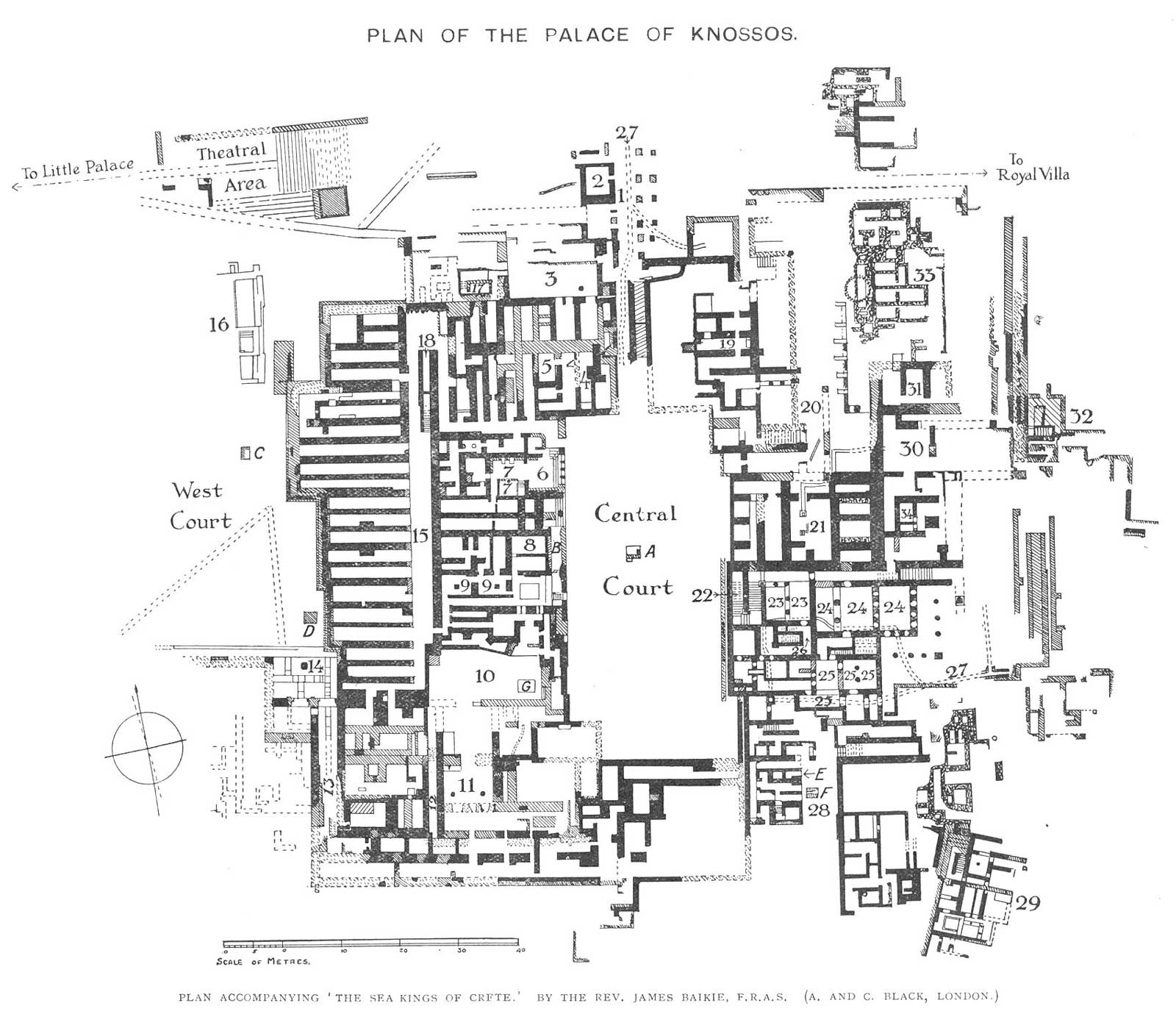
|
|
Plan of the palace at Knossos (Crete), Greece, ca. 1700–1400 BCE.
|

|
|
Bull-leaping, from the palace at Knossos (Crete), Greece, ca. 1450–1400 BCE. Fresco, approx. 2’ 8” high, including border.
|

|
|
Marine Style octopus jar, from Palaikastro (Crete), Greece, ca. 1500 BCE.
|
|
|
|
Harvester Vase, from Hagia Triada (Crete), Greece, ca. 1500 BCE. Steatite, greatest diameter approx. 5”.
|

|
|
Corbeled gallery in the walls of the citadel, Tiryns, Greece, ca. 1400–1200 BCE.
|

|
|
Lion Gate, Mycenae, Greece, ca. 1300–1250 BCE. Limestone, relief panel approx. 9’ 6” high.
|

|
|
Vault of the tholos of the Treasury of Atreus, Mycenae, Greece, ca. 1300–1250 BCE. Approx. 43’ high.
|

|
|
Minoan woman or goddess (La Parisienne), from the palace at Knossos (Crete), Greece, ca. 1450–1400 BCE. Fragment of a fresco, approx. 10” high.
|

|
|
Flotilla, detail of Miniature Ships Fresco, from Room 5, West House, Akrotiri, Thera (Cyclades), Greece, ca. 1650 BCE. Fresco, approx. 1’ 5” high.
|

|
|
Landscape with swallows (Spring Fresco), from Room Delta 2, Akrotiri, Thera (Cyclades), Greece, ca. 1650 BCE. Fresco, approx. 7’ 6” high.
|

|
|
Kamares Ware jar, from Phaistos (Crete), Greece, ca. 1800–1700 BCE.
|

|
|
Sarcophagus, from Hagia Triada (Crete), Greece, ca. 1450–1400 BCE. Painted limestone, approx. 4’ 6” long.
|

|
|
Young god (?), from Palaikastro (Crete), Greece, ca. 1500–1475 BCE. Ivory, gold, serpentine, and rock crystal, original height approx. 1’ 7 1/2”.
|
|
|
|
Snake Goddess, from the palace at Knossos (Crete), Greece, ca. 1600 BCE. Faience, approx. 1’ 1 1/2” high.
|

|
|
Aerial view of the citadel at Tiryns, Greece, ca. 1400–1200 BCE.
|
|
Three methods of spanning a passageway:
|
|
(a) post and lintel, (b) corbeled arch, (c) arch. |

|
|
Plan of the palace and southern part of the citadel, Tiryns, Greece, ca. 1400–1200 BCE.
|

|
|
Treasury of Atreus, Mycenae, Greece, ca. 1300–1250 BCE.
|

|
|
Funerary mask, from Grave Circle A, Mycenae, Greece, ca. 1600–1500 BCE. Beaten gold, approx. 1’ high.
|

|
|
Inlaid dagger blade with lion hunt, from Grave Circle A, Mycenae, Greece, ca. 1600–1500 BCE. Bronze, inlaid with gold, silver, and niello, approx. 9” long
|

|
|
Female head, from Mycenae, Greece, ca. 1300–1250 BCE. Painted plaster, approx. 6 1/2” high.
|

|
|
Warrior Vase, from Mycenae, Greece, ca. 1200 BCE. Approx. 1’ 4” high.
|

|
|
Geometric krater, from the Dipylon cemetery, Athens, Greece, ca. 740 BCE. Approx. 3’ 4 1/2” high.
|

|
|
Plan of Temple A, Prinias, Greece, ca. 625 BCE.
|

|
|
Calf Bearer (Moschophoros), dedicated by Rhonbos on the Acropolis, Athens, Greece, ca. 560 BCE.
|
|
Kroisos, from Anavysos, Greece, ca. 530 BCE. Marble, approx. 6’ 4” high.
|

|
|
Temple of Hera I (“Basilica”), Paestum, Italy, ca. 550 BCE.
|

|
|
EXEKIAS, Achilles and Ajax playing a dice game (detail from an Attic black-figure amphora), from Vulci, Italy, ca. 540–530 BCE. Whole vessel approx. 2’ high.
|

|
|
EUPHRONIOS, Herakles wrestling Antaios (detail of an Attic red-figure calyx krater), from Cerveteri, Italy, ca. 510 BCE. Whole vessel approx. 1’ 7” high.
|

|
|
Plan (left) and restored cutaway view (right) of the Temple of Aphaia, Aegina, Greece, ca. 500–490 BCE.
|

|
|
Kritios Boy, from the Acropolis, Athens, Greece, ca. 480 BCE. Marble, approx. 2’ 10” high. early
|
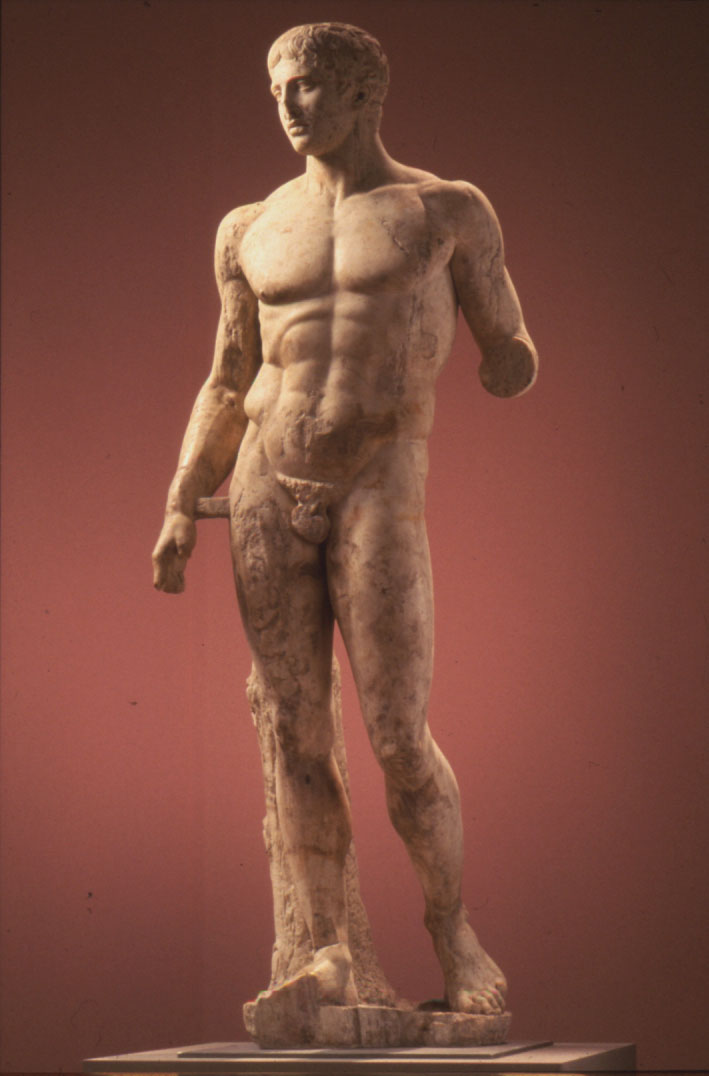
|
|
POLYKLEITOS, Doryphoros (Spear Bearer). Roman marble copy from Pompeii, Italy, after a bronze original of ca. 450–440 BCE, 6’ 11” high.
|

|
|
IKTINOS and KALLIKRATES, Parthenon, the Temple of Athena Parthenos (view from the northwest), Acropolis, Athens, Greece, 447–438 BCE.
|

|
|
Plan of the Parthenon, Acropolis, Athens, Greece, with diagram of sculptural program (after A. Stewart), 447–432 BCE.
|

|
|
Grave stele of Hegeso, from the Dipylon cemetery, Athens, Greece, ca. 400 BCE. Marble, 5’ 2” high.
|

|
|
PRAXITELES, Aphrodite of Knidos. Roman marble copy after an original of ca. 350–340 BCE.
|

|
|
LYSIPPOS, Apoxyomenos (Scraper). Roman marble copy after a bronze original of ca. 330 BCE, approx. 6’ 9” high. late
|
|
|
|
PHILOXENOS OF ERETRIA, Battle of Issus, ca. 310 BCE. Roman copy (Alexander Mosaic) from the House of the Faun, Pompeii, Italy, late second or early first century BCE. Tessera mosaic
|
|
|
|
Reconstructed west front of the Altar of Zeus, from Pergamon, Turkey, ca. 175 BCE.
|

|
|
Seated boxer, from Rome, Italy, ca. 100–50 BCE. Bronze, approx. 4’ 2 1/2” high. Hellenistic
|

|
|
ATHANADOROS, HAGESANDROS, and POLYDOROS OF RHODES, Laocoön and his sons, from Rome, Italy, early first century CE Marble, approx. 7’ 10 1/2” high. Hellenistic....Roman patronage
|

|
|
EPIGONOS(?), Dying Gaul. Roman marble copy after a bronze original from Pergamon, Turkey, ca. 230–220 BCE, approx. 3’ 1/2” high Hellenistic
|
| Greek Time Periods |
|
Geometric Orientalized Archaic Early Classical High Classical Late Classical Hellenistic |
|
Hero and centaur (Herakles and Nessos?), ca. 750–730 BCE. geometric
|

|
|
Mantiklos Apollo, statuette of a youth dedicated by Mantiklos to Apollo, from Thebes, Greece, ca. 700–680 BCE. orientalizing
|
|
|
|
Corinthian black-figure amphora with animal friezes, from Rhodes, Greece, ca. 625–600 BCE.
|

|
|
Lintel of Temple A, Prinias, Greece, ca. 625 BCE.
|

|
|
Lady of Auxerre, statue of a goddess or kore, ca. 650–625 BCE. Limestone, approx. 2’ 1 1/2” high orientalizing
|

|
|
Kouros, ca. 600 BCE. Marble, approx. 6’ 1/2” high. archaic, first idealized
|

|
|
Peplos Kore, from the Acropolis, Athens, Greece, ca. 530 BCE.
|

|
|
Kore, from the Acropolis, Athens, Greece, ca. 520–510 BCE. Marble, approx. 1’ 9 1/2” high
|

|
|
Plan of the Temple of Hera I, Paestum, Italy, ca. 550 BCE.
|

|
|
West pediment from the Temple of Artemis, Corfu, Greece, ca. 600–580 BCE. Limestone, greatest height approx. 9’ 4”.
|
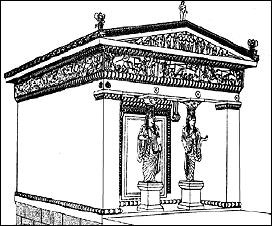
|
|
Reconstruction drawing of the Siphnian Treasury, Delphi, Greece, ca. 530 BCE. archaic
|

|
|
Gigantomachy, detail of the north frieze of the Siphnian Treasury, Delphi, Greece, ca. 530 BCE. Marble, approx. 2’ 1” high
|
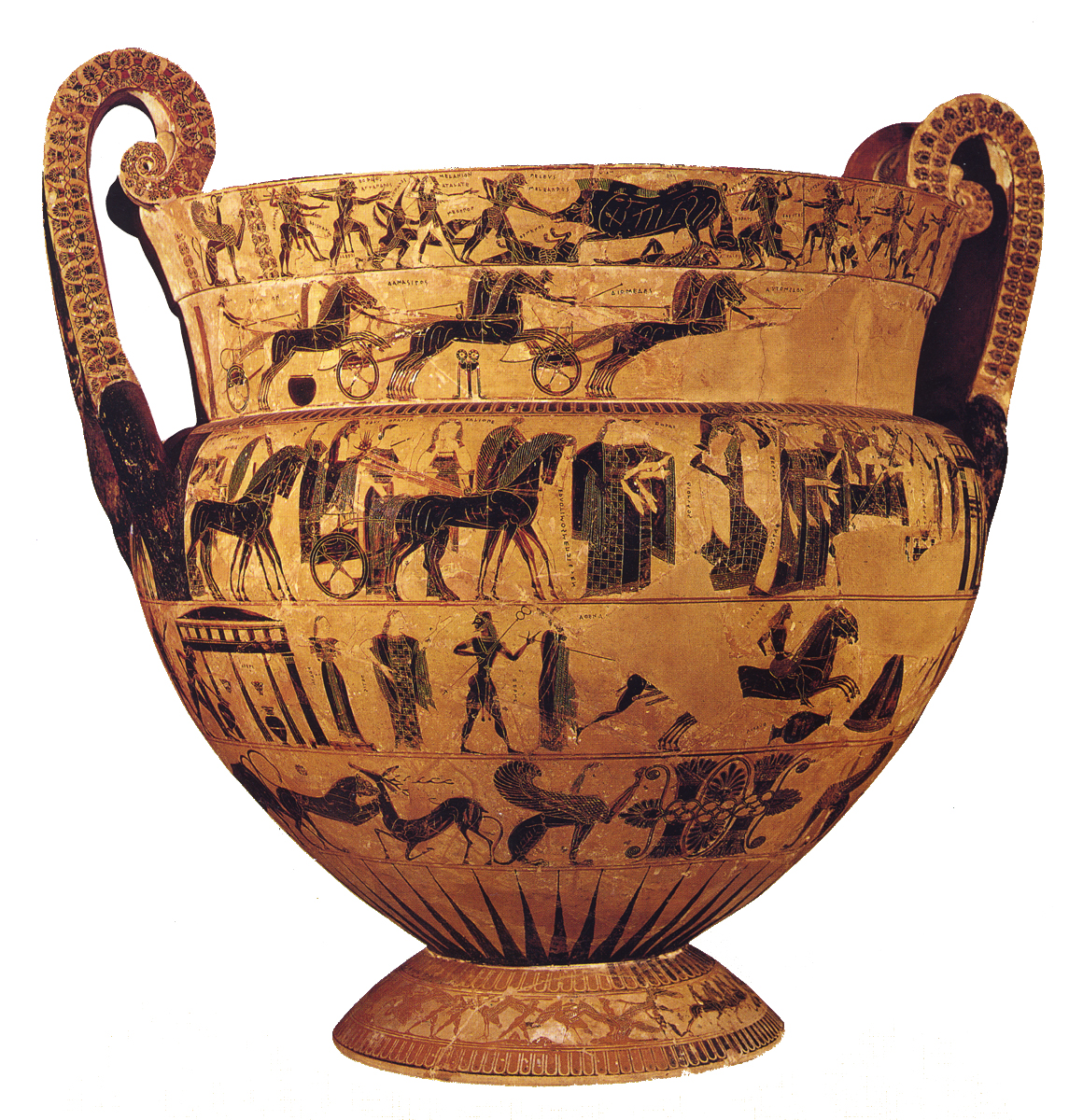
|
|
KLEITIAS and ERGOTIMOS, François Vase (Attic black-figure volute krater), from Chiusi, Italy, ca. 570 BCE.
|

|
|
ANDOKIDES PAINTER, Achilles and Ajax playing a dice game (Attic bilingual amphora), from Orvieto, Italy, ca. 525–520 BCE.
|

|
|
EUTHYMIDES, Three revelers (Attic red-figure amphora), from Vulci, Italy, ca. 510 BCE.
|

|
|
ONESIMOS, Girl preparing to bathe (interior of an Attic red-figure kylix), from Chiusi, Italy, ca. 490 BCE. Tondo approx. 6” in diameter.
|
|
|
|
Temple of Aphaia, Aegina, Greece, ca. 500–490 BCE.
|
|
|
|
West pediment of the Temple of Aphaia, Aegina, Greece, ca. 500-490 BCE. Marble, approx. 5’ 8” high at center.
|
|
|
|
Dying warrior, from the west pediment of the Temple of Aphaia, Aegina, Greece, ca. 500–490 BCE. Marble, approx. 5’ 2 1/2” long.
|
|
|
|
Dying warrior, from the east pediment of the Temple of Aphaia, Aegina, Greece, ca. 490–480 BCE. Marble, approx. 6’ 1” long.
|

|
|
Temple of Hera II, Paestum, Italy, ca. 460 BCE. early classical
|

|
|
East pediment from the Temple of Zeus, Olympia, Greece, ca. 470–456 BCE. Marble
|
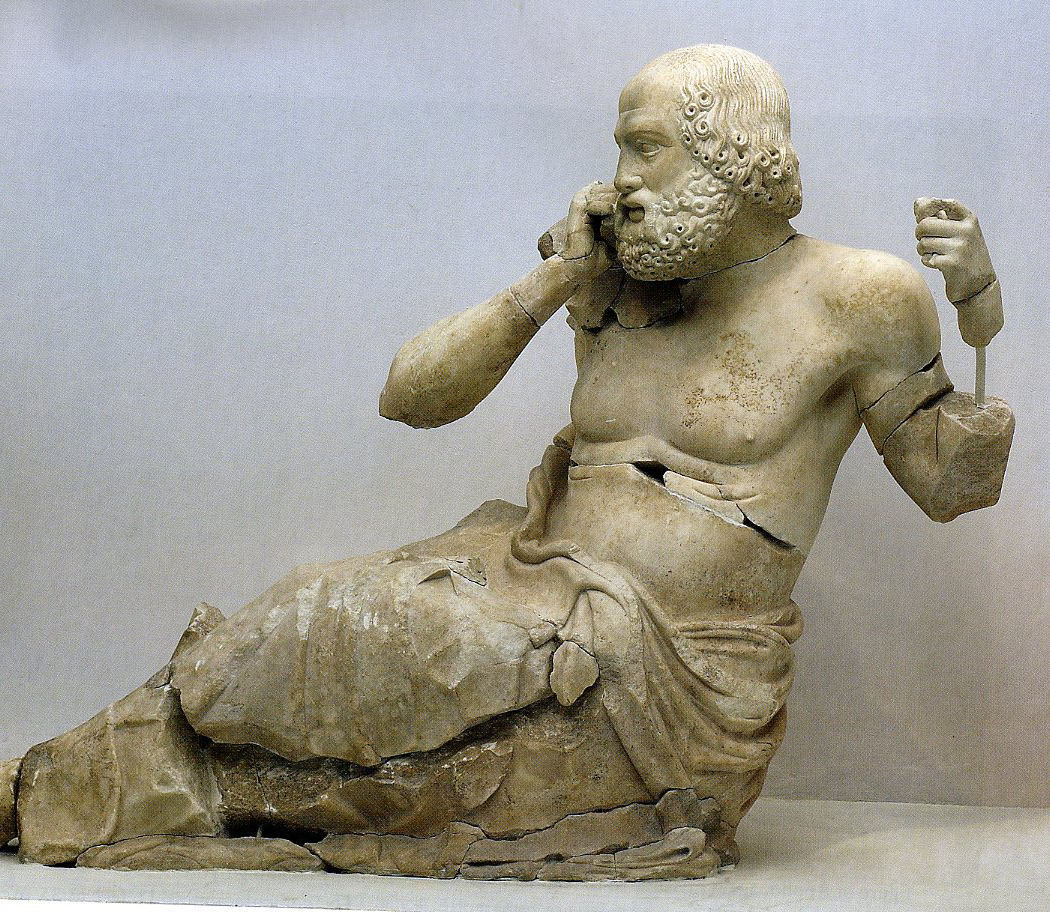
|
|
Seer, from the east pediment of the Temple of Zeus, Olympia, Greece, ca. 470–456 BCE. Marble, approx. 4’ 6” high.
|

|
|
Athena, Herakles, and Atlas with the apples of the Hesperides, metope from the Temple of Zeus, Olympia, Greece, ca. 470–456 BCE. Marble,
|

|
|
Warrior, from the sea off Riace, Italy, ca. 460–450 BCE. Bronze, approx. 6’ 6” high.
|

|
|
Charioteer, from a group dedicated by Polyzalos of Gela in the Sanctuary of Apollo, Delphi, Greece, ca. 470 BCE. Bronze,
|

|
|
Zeus (or Poseidon?), from the sea off Cape Artemision, Greece, ca. 460–450 BCE.
|

|
|
MYRON, Diskobolos (Discus Thrower). Roman marble copy after a bronze original of ca. 450 BCE, 5’ 1” high.
|
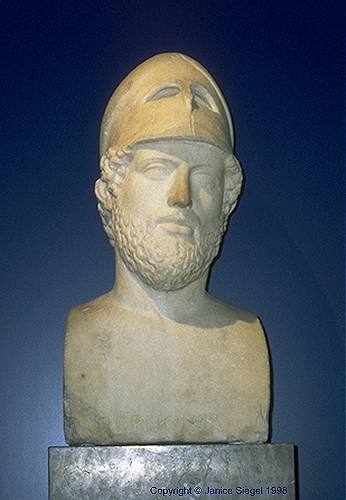
|
|
KRESILAS, Pericles. Roman marble herm copy after a bronze original of ca. 429 BCE, approx. 6’ high.
|

|
|
Model of the Acropolis, Athens, Greece, 1. Panteon 2. Propylaia 3. Erechtheion 4. Temple of Athena Nike.
|

|
|
PHIDIAS, Athena Parthenos, in the cella of the Parthenon, Acropolis, Athens, Greece, ca. 438 BCE. Model of the lost statue, which was approx. 38’ tall.
|

|
|
Helios and his horses, and Dionysos (Herakles?), from the east pediment of the Parthenon, Acropolis, Athens, Greece, ca. 438–432 BCE.
|

|
|
Three goddesses (Hestia, Dione, and Aphrodite?), from the east pediment of the Parthenon, Acropolis, Athens, Greece, ca. 438–432 BCE. Marble,
|

|
|
Details of the Panathenaic Festival procession frieze, from the Parthenon, Acropolis, Athens, Greece, ca. 447–438 BCE. Marble, approx. 3’ 6” high.
|
|
|
|
MNESIKLES, Propylaia (view from the northeast), Acropolis, Athens, Greece, 437–432 BCE.
|
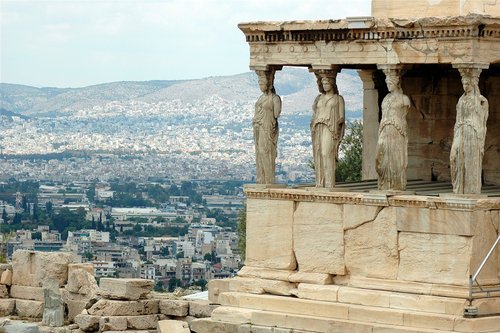
|
|
Erechtheion (view from the southeast), Acropolis, Athens, Greece, ca. 421–405 BCE.
|

|
|
Plan of the Erechtheion, Acropolis, Athens, Greece, ca. 421–405 BCE.
|

|
|
Caryatid from the south porch of the Erechtheion, Acropolis, Athens, Greece, ca. 421–405 BCE. marble
|

|
|
KALLIKRATES, Temple of Athena Nike (view from the northeast), Acropolis, Athens, Greece, ca. 427–424 BCE.
|
|
|
|
Nike adjusting her sandal, from the south side of the parapet of the Temple of Athena Nike, Acropolis, Athens, Greece, ca. 410 BCE.
|

|
|
detail of seated woman: Hegeso
|
|
|
|
ACHILLES PAINTER, Warrior taking leave of his wife (Attic white-ground lekythos), from Eretria, Greece, ca. 440 BCE.
|
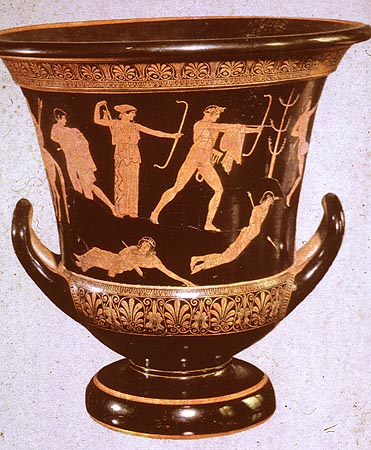
|
|
NIOBID PAINTER, Artemis and Apollo slaying the children of Niobe (Attic red-figure calyx krater), from Orvieto, Italy, ca. 450 BCE.
|

|
|
PHIALE PAINTER, Hermes bringing the infant Dionysos to Papposilenos (Attic white-ground calyx krater), from Vulci, Italy, ca. 440–435 BCE.
|

|
|
Youth diving, painted ceiling of the Tomb of the Diver, Paestum, Italy, ca. 480 BCE.
|
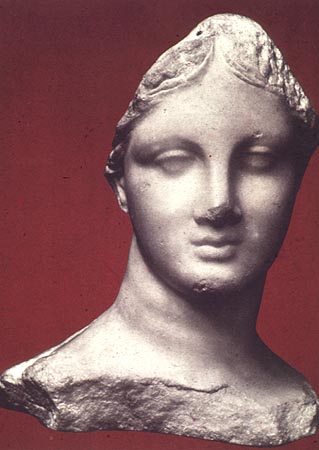
|
|
Head of a woman, from Chios, Greece, ca. 320–300 BCE. Marble, approx. 1’ 2” high
|

|
|
PRAXITELES, Hermes and the infant Dionysos, from the Temple of Hera, Olympia, Greece. Marble copy after an original of ca. 340 BCE
|

|
|
Head of Herakles or Telephos, from the west pediment of the Temple of Athena Alea, Tegea, Greece, ca. 340 BCE
|

|
|
Grave stele of a young hunter, found near the Ilissos River, Athens, Greece, ca. 340–330 BCE.
|
|
|
|
LYSIPPOS, Weary Herakles (Farnese Herakles). Roman marble copy from Rome, Italy, signed by GLYKON OF ATHENS, after a bronze original of ca. 320 BCE.
|

|
|
Head of Alexander the Great, from Pella, Greece, ca. 200–150 BCE.
|

|
|
GNOSIS, Stag hunt, from Pella, Greece, ca. 300 BCE. Pebble mosaic, figural panel 10’ 2” high.
|

|
|
POLYKLEITOS THE YOUNGER, Theater, Epidauros, Greece, ca. 350 BCE.
|
|
|
|
THEODOROS OF PHOKAIA, Tholos, Delphi, Greece, ca. 375 BCE.
|
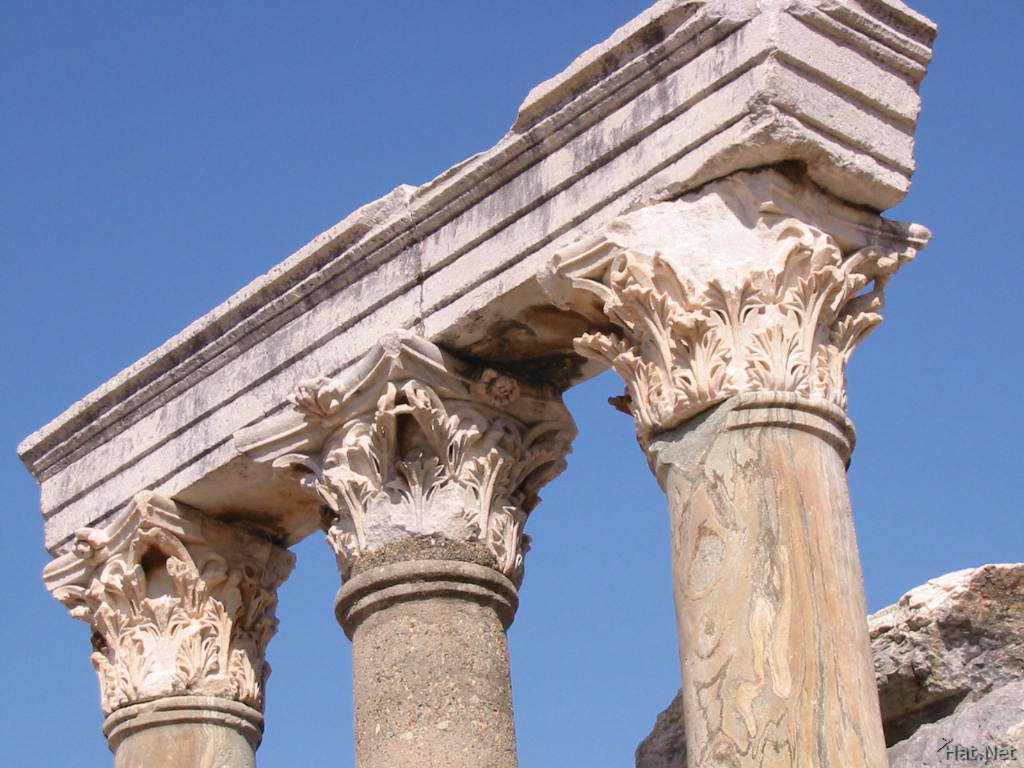
|
|
POLYKLEITOS THE YOUNGER, Corinthian capital, from the Tholos, Epidauros, Greece, ca. 350 BCE.
|

|
|
Choragic Monument of Lysikrates, Athens, Greece, 334 BCE.
|

|
|
PAIONIOS OF EPHESOS and DAPHNIS OF MILETOS, Temple of Apollo, Didyma, Turkey, begun 313 BCE.
|

|
|
Model of the city of Priene, Turkey, fourth century BCE and later
|

|
|
Model of the city of Priene, Turkey, fourth century BCE and later.
|

|
|
Plan of House XXXII, Priene, Turkey, fourth century BCE.
|

|
|
Stoa of Attalos II, Agora, Athens, Greece, ca. 150 BCE
|
|
|
|
Athena battling Alkyoneos, detail of the gigantomachy frieze, from the Altar of Zeus, Pergamon, Turkey. Marble, approx. 7’ 6” high.
|
|
|
|
EPIGONOS(?), Gallic chieftain killing himself and his wife. Roman marble copy after a bronze original from Pergamon, Turkey, ca. 230–220 BCE, approx. 6’ 11” high.
|
|
|
|
Nike alighting on a warship (Nike of Samothrace), from Samothrace, Greece, ca. 190 BCE. Marble,
|

|
|
ALEXANDROS OF ANTIOCH-ON-THE-MEANDER, Aphrodite (Venus de Milo), from Melos, Greece, ca. 150–125 BCE. Marble,
|

|
|
Aphrodite, Eros, and Pan, from Delos, Greece, ca. 100 BCE.
|

|
|
Sleeping satyr (Barberini Faun), from Rome, Italy, ca. 230–200 BCE. definitely Hellenistic
|

|
|
Old market woman, ca. 150–100 BCE. Marble, approx. 4’ 1/2” high.
|
|
|
|
POLYEUKTOS, Demosthenes. Roman marble copy after a bronze original of ca. 280 BCE. 6’ 7 1/2” high not a portrait.... a sensitive study of physical types?
|

|
|
ATHANADOROS, HAGESANDROS, and POLYDOROS OF RHODES, Odysseus, from Sperlonga, Italy, early first century CE. Marble,
|

|
|
Fibula with Orientalizing lions, from the Regolini-Galassi Tomb, Cerveteri, Italy, ca. 650–640 BCE.
|

|
|
Model of a typical Etruscan temple of the sixth century BCE, as described by Vitruvius
|

|
|
Apulu (Apollo), from the roof of the Portonaccio Temple, Veii, Italy, ca. 510–500 BCE. Painted terracotta
|
|
|
|
Sarcophagus with reclining couple, from Cerveteri, Italy, ca. 520 BCE. Painted terracotta
|
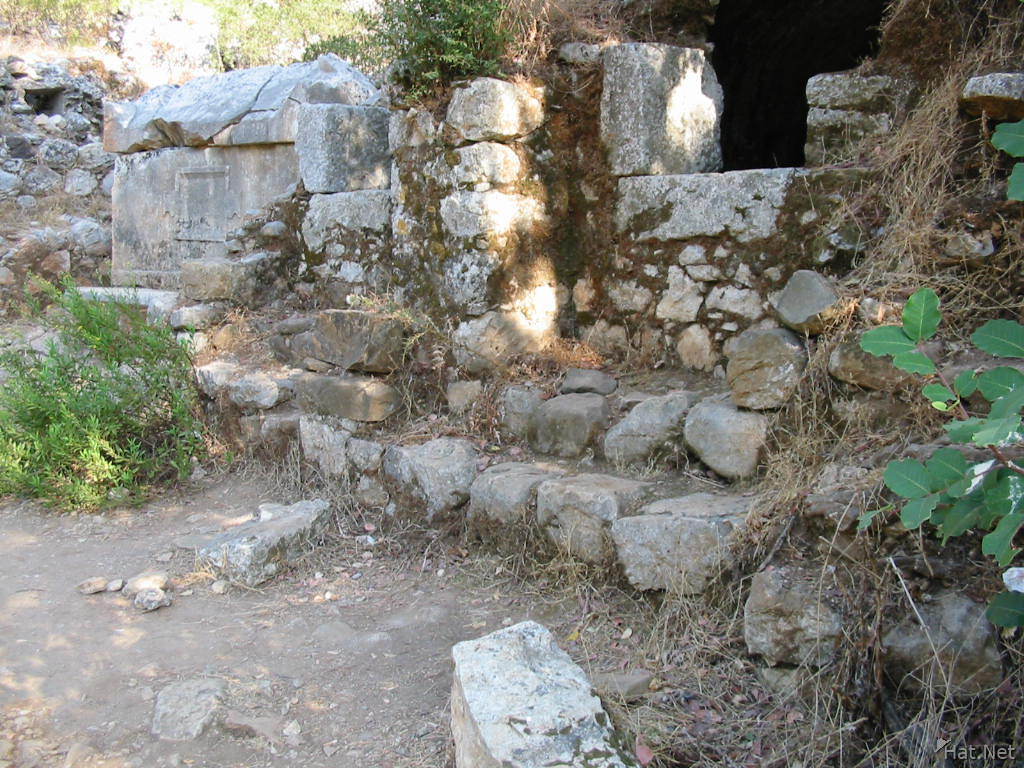
|
|
Aerial view of Banditaccia necropolis, Cerveteri, Italy, seventh to second centuries BCE.
|
|
|
|
Interior of the Tomb of the Reliefs, Cerveteri, Italy, third century BCE.
|

|
|
Leopards, banqueters, and musicians, detail of mural paintings in the Tomb of the Leopards, Tarquinia, Italy, ca. 480–470 BCE.
|

|
|
Capitoline Wolf, from Rome, Italy, ca. 500–480 BCE. Bronze, approx. 2’ 7 1/2” high
|

|
|
Chimera of Arezzo, from Arezzo, Italy, first half of fourth century BCE. Bronze,
|

|
|
NOVIOS PLAUTIOS, Ficoroni Cista, from Palestrina, Italy, late fourth century BCE. Bronze
|

|
|
Porta Marzia (Gate of Mars), Perugia, Italy, second century BCE.
|
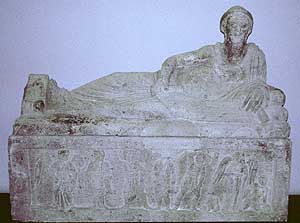
|
|
Sarcophagus of Lars Pulena, from Tarquinia, Italy, early second century BCE. Tufa
|

|
|
Aule Metele (Arringatore), from Cortona, near Lake Trasimeno, Italy, early first century BCE Etruscan or Roman??!!?!?
|
|
|
|
Temple of “Fortuna Virilis” (Temple of Portunus), Rome, Italy, ca. 75 BCE.
|
|
|
|
Temple of Vesta (?), Tivoli, Italy, early first century BCE
|
|
|
|
Reconstruction drawing of the Sanctuary of Fortuna Primigenia, Palestrina, Italy, late second century BCE.
|
|
|
|
Aerial view of the amphitheater, Pompeii, Italy, ca. 70 BCE.
|
|
|
|
Atrium of the House of the Vettii, Pompeii, Italy, second century BCE, rebuilt 62–79 CE
|
|
|
|
Maison Carrée, Nîmes, France, ca. 1–10 CE. EARLY...FORTUNA IS REPUBLICAN!
|

|
|
Pont-du-Gard, Nîmes, France, ca. 16 BCE.
|
|
|
|
Porta Maggiore, Rome, Italy, ca. 50 CE.
|
 
|
|
SEVERUS and CELER, plan (above) and section (below) of the octagonal hall of the Domus Aurea (Golden House) of Nero, Rome, Italy, 64–68 CE.
|

|
|
Colosseum (Flavian Amphitheater), Rome, Italy, ca. 70–80 CE.
|
|
|
|
Arch of Titus, Rome, Italy, after 81 CE
|
| ART OF REPUBLICAN ROME |
|
VERISM FREEDMEN FREEDWOMEN FIRST STYLE SECOND STYLE THIRD STYLE FOURTH STYLE |
| three people, man, woman, other guy |
|
Funerary relief with portraits of the Gessii, from Rome(?), Italy, ca. 30 BCE. Marble republican
|
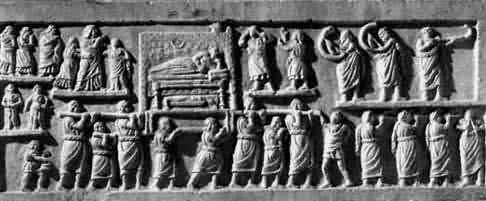
|
|
Relief with funerary procession, from Amiternum, Italy, second half of first century BCE. Limestone, republican!
|

|
|
Head of a Roman patrician, from Otricoli, Italy, ca. 75–50 BCE. verism! "brutally realistic"
|

|
|
Brawl in the Pompeii amphitheater, wall painting from House I,3,23, Pompeii, Italy, ca. 60–79 CE
|

|
|
The old farmer of Corycus, folio 7 verso of the Vatican Vergil, ca. 400–420 CE.
|

|
|
Neptune and Amphitrite, wall mosaic in the summer triclinium of the House of Neptune and Amphitrite, Herculaneum, Italy, ca. 62–79 CE.
|
|
|
|
Portrait of Augustus as general, from Primaporta, Italy, copy of a bronze original of ca. 20 BCE. Marble, 6’ 8” high. Vatican Museums, Rome. early eternally youthful!
|

|
|
Portrait bust of Livia, from Faiyum, Egypt, early first century CE. Marble, approx. 1’ 1 1/2” high early
|
|
|
|
Ara Pacis Augustae (Altar of Augustan Peace), Rome, Italy, 13–9 BCE. early
|
|
|
|
Female personification (Tellus?), panel from the east facade of the Ara Pacis Augustae, Rome, Italy, 13–9 BCE. Marble, approx. 5’ 3” high. early
|
|
|
|
Procession of the imperial family, detail of the south frieze of the Ara Pacis Augustae, Rome, Italy, 13–9 BCE. Marble, approx. 5’ 3” high.
|

|
|
Portrait of Vespasian, ca. 75–79 CE. Marble, approx. 1’ 4” high. Ny Carlsberg Glyptotek, Copenhagen.
|
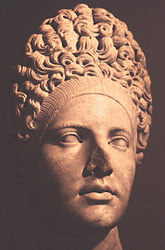
|
|
Portrait bust of a Flavian woman, from Rome, Italy, ca. 90 CE. Marble, approx. 2’ 1” high. Museo Capitolino, Rome. early
|
|
|
|
Spoils of Jerusalem, relief panel from the Arch of Titus, Rome, Italy, after 81 CE. Marble, approx. 7’ 10” high.
early |

|
|
Apollodorus of Damascus, model of Forum of Trajan, Rome, Italy, dedicated 112 CE. Reconstruction by James E. Packer and John Burge. 1) Temple of Trajan, 2) Column of Trajan, 3) Libraries, 4) Basilica Ulpia, 5) Forum, 6) Equestrian statue of Trajan.
|
|
|
|
Column of Trajan, Forum of Trajan, Rome, Italy, dedicated 112 CE.
|
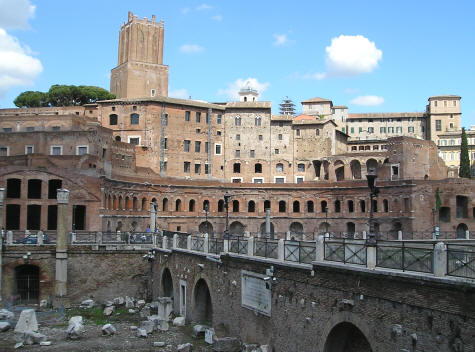
|
|
APOLLODORUS OF DAMASCUS, aerial view of Markets of Trajan, Rome, Italy, ca. 100–112 CE.
|
,_Algeria_04966r.jpg)
|
|
Arch of Trajan, Benevento, Italy, ca. 114–118 CE. middle
|
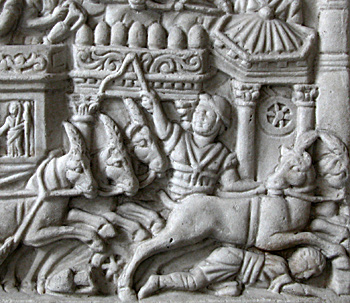
|
|
Funerary relief of a circus official, from Ostia, Italy, ca. 110–130 CE. Marble, approx. 1’ 8” high. Vatican Museums, Rome. middle continuous narration
|

|
|
Portrait bust of Hadrian as general, from Tel Shalem, Israel, ca. 130–138 CE. Bronze, middle idealized
|

|
|
Aerial view of the Pantheon, Rome, Italy, 118–125 CE. middle
|
|
|
|
Canopus and Serapeum, Hadrian’s Villa, Tivoli, Italy, ca. 130–138 CE.
|
.JPG)
|
|
Al-Khazneh (“Treasury”), Petra, Jordan, second century CE.
|

|
|
Model of an insula, Ostia, Italy, second century CE. Museo della Civiltà Romana, Rome.
|
|
|
|
Ceiling and wall paintings in Room IV of the Insula of the Painted Vaults, Ostia, Italy, early third century CE
|

|
|
Figure 10-56 Funerary reliefs of a vegetable vendor (left) and a midwife (right), from Ostia, Italy, second half of second century CE. Painted terracotta, approx. 1’ 5” and 11” high, respectively. Museo Ostiense, Ostia.
|

|
| Apotheosis of Antoninus Pius and Faustina, pedestal of the Column of Antoninus Pius, Rome, Italy, ca. 161 CE. Marble, approx. 8’ 1 1/2” high. Vatican Museums, Rome. |

|
|
Decursio, pedestal of the Column of Antoninus Pius, Rome, Italy, ca. 161 CE. Marble, approx. 8’ 1 1/2” high. Vatican Museums, Rome.
|

|
|
Equestrian statue of Marcus Aurelius, from Rome, Italy, ca. 175 CE. Bronze, approx. 11’ 6” high. Musei Capitolini, Rome.
|
|
|
|
Portrait of Marcus Aurelius, detail of a relief from a lost arch, Rome, Italy, ca. 175–180 CE. Marble, approx. life-size. Palazzo dei Conservatori, Rome.
|

|
|
Sarcophagus with the myth of Orestes, ca. 140–150 CE. Marble, 2’ 7 1/2” high. Cleveland Museum of Art, Cleveland.
|

|
|
Asiatic sarcophagus with kline portrait of a woman, from Rapolla, near Melfi, Italy, ca. 165–170 CE. Marble, approx. 5’ 7” high. Museo Nazionale Archeologico del Melfese, Melfi.
|

|
|
Mummy portrait of a man, from Faiyum, Egypt, ca. 160–170 CE. Encaustic on wood, approx. 1’ 2” high. Albright-Knox Art Gallery, Buffalo. high
|

|
|
Painted portrait of Septimius Severus and his family, from Egypt, ca. 200 CE. Tempera on wood, approx. 1’ 2” diameter. Staatliche Museen, Berlin.
|

|
|
Portrait of Caracalla, ca. 211–217 CE. Marble, approx. 1’ 2” high. Metropolitan Museum of Art, New York.
|

|
|
Chariot procession of Septimius Severus, relief from the Arch of Septimius Severus, Lepcis Magna, Libya, 203 CE. Marble, approx. 5’ 6” high. Castle Museum, Tripoli.
|

|
|
Plan of the central section of the Baths of Caracalla, Rome, Italy, 212–216 CE. 1) Natatio, 2) Frigidarium, 3) Tepidarium, 4) Caldarium, 5) Palaestra. The bathing, swimming, and exercise areas were surrounded by landscaped gardens, lecture halls, and other rooms, all enclosed within a great concrete perimeter wall.
|
|
|
|
Reconstruction drawing of the central hall (frigidarium) of the Baths of Caracalla, Rome, Italy, 212–216 CE.
|

|
|
Heroic portrait of Trebonianus Gallus, from Rome, Italy, 251–253 CE. Bronze, approx. 7’ 11” high. Metropolitan Museum of Art, New York
|
|
|
|
Battle of Romans and barbarians (Ludovisi Battle Sarcophagus), from Rome, Italy, ca. 250–260 CE. Marble, approx. 5’ high. Museo Nazionale Romano-Palazzo Altemps, Rome late
|
|
|
|
Sarcophagus of a philosopher, ca. 270–280 CE. Marble, approx. 4’ 11” high. Vatican Museums, Rome.
|

|
|
Plan and reconstruction drawing of the Temple of Venus, Baalbek, Lebanon, third century CE
|
|
|
|
Portraits of the four tetrarchs, from Constantinople, ca. 305 CE. Porphyry, approx. 4’ 3” high. Saint Mark’s, Venice. late fading empire!!
|

|
|
Arch of Constantine, Rome, Italy, 312–315 CE (south side). late!
|

|
|
Distribution of largess, detail of the north frieze of the Arch of Constantine, Rome, Italy, 312–315 CE. Marble, approx. 3’ 4” high.
|
|
|
|
Portrait of Constantine, from the Basilica Nova, Rome, Italy, ca. 315–330 CE. Marble, approx. 8’ 6” high. Palazzo dei Conservatori, Rome.
|

|
|
Reconstruction drawing of the Basilica Nova (Basilica of Constantine), Rome, Italy, ca. 306–312 CE
|

|
|
Aula Palatina, Trier, Germany, early fourth century CE (exterior).
|
| Early Christian Years |
|
245-526
|

|
|
Interior of the synagogue at Dura-Europos, Syria, with wall-paintings of Old Testament themes, ca. 245–256. Tempera on plaster. Reconstruction in National Museum, Damascus.
|

|
|
The Good Shepherd, the story of Jonah, and orants, painted ceiling of a cubiculum in the Catacomb of Saints Peter and Marcellinus, Rome, Italy, early fourth century.
|
|
|
|
Sarcophagus with philosopher, orant, and Old and New Testament scenes, Santa Maria Antiqua, Rome, Italy, ca. 270. Marble, 1’ 11 1/4” X 7’ 2”.
|

|
|
Christ seated, from Civita Latina, Italy, ca. 350–375. Marble, approx. 2’ 4 1/2” high. Museo Nazionale Romano—Palazzo Massimo alle Terme, Rome.
|
|
|
|
Interior of Santa Sabina, Rome, Italy, 422–432.
|

|
|
Detail of vault mosaic in the ambulatory of Santa Costanza, Rome, Italy, ca. 337–351.
|
|
|
|
Christ as Sol Invictus, detail of a vault mosaic in the Mausoleum of the Julii, Rome, Italy, late third century.
|

|
|
The parting of Lot and Abraham, mosaic in the nave of Santa Maria Maggiore, Rome, Italy, 432–440.
|

|
|
Mausoleum of Galla Placidia, Ravenna, Italy, ca. 425.
|

|
|
Christ as the Good Shepherd, mosaic from the entrance wall of the Mausoleum of Galla Placidia, Ravenna, Italy, ca. 425.
|
|
|
|
Interior of Sant’Apollinare Nuovo, Ravenna, Italy, dedicated 504.
|

|
|
Miracle of the loaves and fishes, mosaic from the top register of the nave wall (above the clerestory windows) of Sant’Apollinare Nuovo, Ravenna, Italy, ca. 504.
|

|
|
Saints Onesiphorus and Porphyrius, detail of the dome mosaic, Church of Saint George, Thessaloniki, Greece, ca. 390–450.
|

|
|
Rebecca and Eliezer at the well, folio 7 recto of the Vienna Genesis, early sixth century. Tempera, gold, and silver on purple vellum, approx. 1’ 1/4” X 9 1/4”. Österreichische Nationalbibliothek, Vienna.
|

|
|
Christ before Pilate, folio 8 verso of the Rossano Gospels, early sixth century. Tempera on purple vellum, approx. 11” X 10 1/4”. Diocesan Museum, Archepiscopal Palace, Rossano.
|
|
|
|
Suicide of Judas and Crucifixion of Christ, plaque from a box, ca. 420. Ivory, 3” X 3 7/8”. British Museum, London.
|

|
|
Woman sacrificing at an altar, right leaf of the Diptych of the Nicomachi and the Symmachi, ca. 400. Ivory, 11 3/4” X 5 1/2”. Victoria and Albert Museum, London.
|

|
|
Dome of the Rock, Jerusalem, 687–692.
|

|
|
Aerial view of the Great Mosque, Damascus, Syria, 706–715.
|

|
|
Detail of a mosaic in the courtyard arcade of the Great Mosque, Damascus, Syria, 706–715.
|

|
|
Detail of a mosaic in the courtyard arcade of the Great Mosque, Damascus, Syria, 706–715.
|
 
|
|
Plan of the Umayyad palace, Mshatta, Jordan, ca. 740–750 (after Alberto Berengo Gardin).
[Key: 1. Entrance gate; 2. Mosque; 3. Small courtyard; 4. Large courtyard; 5. Audience hall.] |
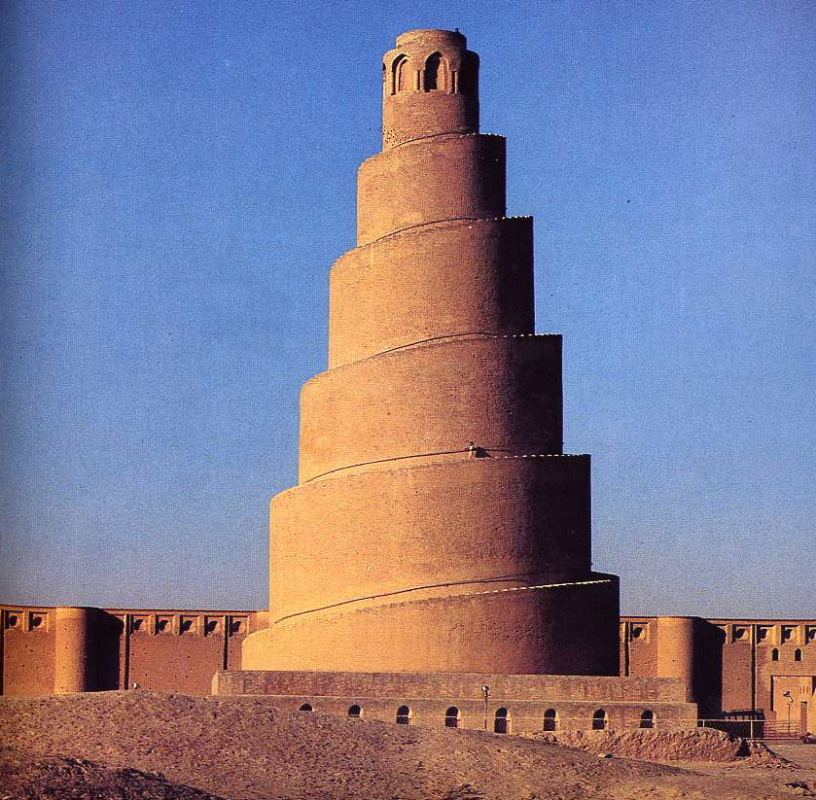
|
|
Malwiya minaret of the Great Mosque, Samarra, Iraq, 848–852.
|

|
|
Mausoleum of the Samanids, Bukhara, Uzbekistan, early tenth century
|

|
|
Prayer hall of the Great Mosque, Córdoba, Spain, eighth to tenth centuries
|

|
|
Mosque of Córdoba
Moorish Portal: Arabesque above portal, South side of the Mezquita |

|
|
SULAYMAN, Ewer in the form of a bird, 796. Brass with silver and copper inlay, 1’ 3” high. Hermitage, Saint Petersburg.
|

|
|
Koran page with beginning of surah 18, al-Kahf (The Cave), ninth or early tenth century. Ink and gold on vellum, 7 1/4” x 10 1/4”. Chester Beatty Library and Oriental Art Gallery, Dublin.
|

|
|
SINAN, Mosque of Selim II, Edirne, Turkey, 1568–1575.
|
|
|
|
Mihrab from the Madrasa Imami, Isfahan, Iran, ca. 1354. Glazed mosaic tilework, 11’ 3” X 7’ 6”. Metropolitan Museum of Art, New York.
|
|
|
|
MAQSUD OF KASHAN, carpet from the funerary mosque of Shaykh Safi al-Din, Ardabil, Iran, 1540. Knotted pile of wool and silk, 34’ 6” X 17’ 7”. Victoria and Albert Museum, London.
|

|
|
MUHAMMAD IBN AL-ZAYN, basin (Baptistère de Saint Louis), from Egypt, ca. 1300. Brass, inlaid with gold and silver, 8 3/4” high. Louvre, Paris.
|
|
Canteen with episodes from the life of Christ, from Syria, ca. 1240–1250. Brass, inlaid with silver, 1’ 2 1/2” diameter. Freer Gallery of Art, Washington, D.C.
|

|
| Justinian as world conqueror (Barberini Ivory), mid-sixth century. Ivory, 1' 1 1/2" X 10 1/2". Louvre, Paris. |
|
|
| Saint Michael the Archangel, right leaf of a diptych, early sixth century. Ivory, approx. 1' 5" X 5 1/2". British Museum, London. |

|
| ANTHEMIUS OF TRALLES and ISIDORUS OF MILETUS, Hagia Sophia (view facing north), Constantinople (Istanbul), Turkey, 532-537. |

|
| Aerial view of San Vitale, Ravenna, Italy, 526-547. |

|
| Choir and apse of San Vitale with mosaic of Christ between two angels, Saint Vitalis, and Bishop Ecclesius, Ravenna, Italy, 526-547. |

|
| Justinian, Bishop Maximianus, and attendants, mosaic from the north wall of the apse, San Vitale, Ravenna, Italy, ca. 547. |
|
|
| Saint Apollinaris amid sheep, apse mosaic, Sant'Apollinare in Classe, Ravenna, Italy, ca. 533-549. |

|
| Ascension of Christ, folio 13 verso of the Rabbula Gospels, from Zagba, Syria, 586. Approx. 1' 1" X 10 1/2". Biblioteca Medicea-Laurenziana, Florence. |

|
| Virgin (Theotokos) and Child between Saints Theodore and George, icon, sixth or early seventh century. Encaustic on wood, 2' 3" X 1' 7 3/8". Monastery of Saint Catherine, Mount Sinai, Egypt. |

|
|

|
| Monastery churches at Hosios Loukas, Greece (view from the east). Katholikon (left), first quarter of eleventh century, and Church of the Theotokos (right), second half of tenth century. |

|
| Interior of Katholikon, Hosios Loukas, Greece, first quarter of eleventh century |

|
| Saint Mark's |

|
| lateANDREI RUBLYEV, Three angels (Old Testament Trinity), ca. 1410. Tempera on wood, 4' 8" X 3' 9". Tretyakov Gallery, Moscow. |

|
|
Great Stupa India |



